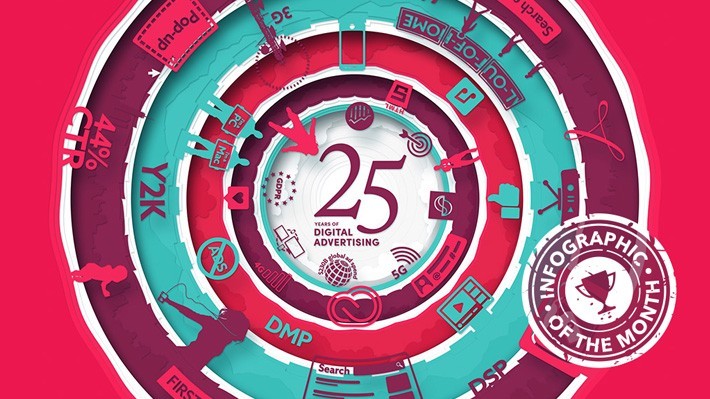Infographic of the Month: A Look Back at 25 Years of Digital Advertising
One of the ironies of growing up in an era of digital marketing is that it’s easy to take previous innovations for granted. We get so immersed in new things emerging in the here and now, whether that’s Tik Tok, smart speakers or Artificial Intelligence (AI), that we tend to forget some of the huge changes our profession has already negotiated – often with a speed and an instinct for applying new technologies that’s hugely impressive.
That’s why any marketer feeling overwhelmed by new platforms or overburdened by new regulations should take a quick look at the infographic below. It’s been created by Adobe’s CMO.com content hub, and in its simple, straightforward way, it’s very inspiring.
A Look Back at 25 Years of Digital Advertising starts its story with the first ever digital display ad, which appeared in 1994. That ad was purchased by AT&T on hotwired.com, a digital offshoot of Wired magazine. It appeared on an internet that couldn’t be searched, since the first search engine (Yahoo, not Google) didn’t appear until the following year. It had no animation, since Flash, the first programming language to introduce rich media to advertising, would only launch in 1996. And, perhaps surprisingly, it wasn’t a pop-up. That unwelcome digital advertising innovation didn’t arrive until 1997.
Despite this lack of technical tools and wizardry, marketers were finding ways to make creative use of the internet from almost the instant it entered the mainstream. They reacted with speed and foresight whenever a new platform or new possibility came along.
It’s fascinating to look back through this timeline and imagine a world of digital marketing without Search Engine Optimisation (SEO), which only emerged as a discipline after the arrival of Google in 1998, pay per click advertising (arrived with Google AdWords in 2000), social media (LinkedIn launched in 2003 and Facebook in 2004) – and broadband internet. Prior to 2005, anyone encountering digital advertising was doing so over a dial-up connection. We’re accustomed to thinking about the launch of the iPhone in 2007 as a major turning point for digital – but it’s impressive how many other major turning points digital advertising had already negotiated by then.
Anyone who doubts digital advertising’s capacity for creativity should perhaps take a look at that first AT&T ad, created by the agency Modem Media. It formed part of an integrated campaign that included TV ads making startlingly accurate predictions about a digital future that included online bookstores, video calling, GPS and more. It’s message, “Have you ever clicked your mouse right here? You Will” echoed the theme of that campaign and led to a primitive landing page that invited users to wonder at how they could explore online images of art galleries without leaving their seats. It was intriguing, it set out to entertain and add value, and it generated a click-through rate (CTR) of 44% that’s impossible to imagine today. It was an imaginative expression of what the internet could be.
Other rapid-fire examples of creativity and innovative thinking occur throughout this infographic: from SMS-based sponsored content pioneered in Finland in 2000 to the surprisingly early emergence of influencer marketing in 2009, to Mondelez finding a way to purchase TV ads programmatically in 2015. It took less than two years from Pokémon Go taking Augmented Reality (AR) mainstream for Michael Kors to invite Facebook users to visualise themselves wearing the brand’s sunglasses.
At the end of this concise history of digital marketing, we encounter the developments that will be challenging marketers over the next two years: how to apply smart speakers and voice technology in a way that makes sense for both brands and their audiences; how to translate AI into more personalised and contextually relevant customer experiences; and how to do all of this while respecting users’ right to privacy – and a new wave of data regulation such as the GDPR. These are big challenges. On the basis of this infographic though, you have to be confident about digital marketers’ ability to rise to them.
This infograhic by Adobe was originally published on cmo.com
Topics: Content marketing Trends, tips, and best practices LinkedIn Ads
Related articles



